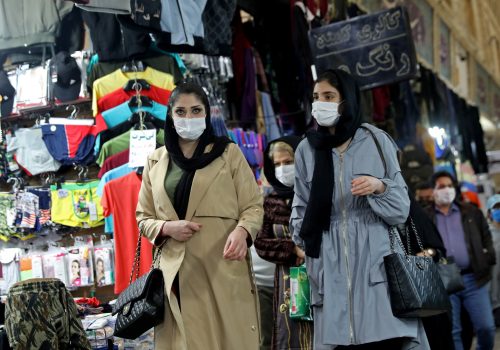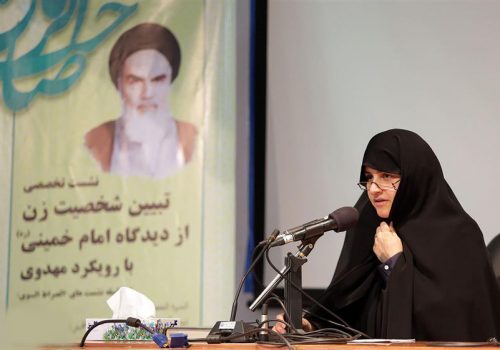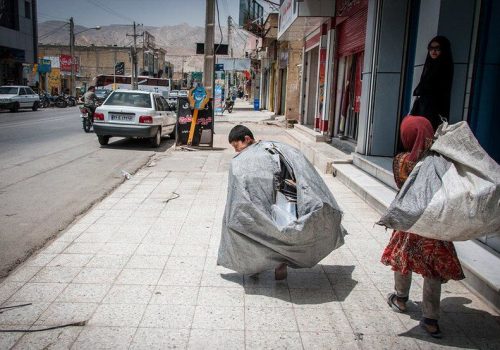Ableism exists online amongst Iranian women’s rights activists. It needs to be addressed.
Iranian women’s rights activism is very much present and made visible on social media with countless hashtags, images, and videos circulating online and going viral to regularly draw attention to important causes, such as freedom of expression, sexual abuse by powerful men, and depicting harassment and abuse of women by security forces. However, in much of what is said and shared about Iranian women’s plight online, disabled Iranian women’s voices often go unheard.
This unequal dynamic within Iranian women’s rights activism online is further compounded by social media algorithms, which favor posts that have a large audience engagement rate. Why then, are disabled women’s voices marginalized online as they so often are offline?
Since the 2009 post-election protests known as the Green Movement, social media has provided a useful platform for activists, journalists, and ordinary citizens alike to highlight human rights issues and violations to a growing audience within and beyond the transnational Iranian public sphere. Of that group, a minority has focused on raising awareness on disability rights issues, such as the Kampayneh Maloolan (disability campaign), a platform that highlights the discrimination faced by disabled Iranians on the regular.
On Twitter and messaging app Telegram—both platforms are blocked by the Islamic Republic and must be accessed via circumvention tools—this campaign provides a window into the activism led by disabled Iranians, most notably through the hashtags #قانون_معلولان (#Disability_Law) and #تصویب_لایحه_معلولان (#Pass_Disability_Bill), a reference to Iran’s Law to Protect the Rights of the Disabled. This was ratified by parliament in 2018 after a Twitter storm in 2017—led by the disability campaign—mobilized users to make the hashtag trend on Persian language Twitter with over 27,000 tweets. However, more than four years later, the bill has yet to be implemented. The campaign’s discourse surrounds disability activism and stands in stark contrast to the lack of representation of disabled Iranians on the platforms of Iranian women’s rights activists.
The intersection of disability and women’s rights movements
It may be unclear from the outside how the disability and women’s rights movements are connected, but the most recent law to be swiftly passed in parliament—notably, the Population Growth Plan (طرح_جوانی_جمعیت#)—is a good example of how the Islamic Republic undermines both Iranian women and disabled Iranians. The law, which passed in March 2021, criminalizes the use of contraceptives and abortion and is set to grant privileges to families with upwards of three children. It also aims to eliminate mandatory pregnancy screenings, raising the risk of mother/child complications and premature death. Financial support for disabled Iranians is already stretched but this law further significantly cuts disability allowance and curtails women’s financial independence as it incentivizes childbearing and marriage.
Under the current economic hardships faced by Iranians due to punitive sanctions, mismanagement, and corruption, many young women will have no other choice but to marry early as a result. Additionally, many disabled Iranians will be left poor without adequate financial aid, leaving them more vulnerable to abuse and dehumanization, with them being considered financial “burdens” on families and the state. While the bill to Protect the Rights of the Disabled accounted for equal access to work, adequate healthcare, and at home support, the Population Growth Plan undermines all these demands by reneging on the rights of the disabled.
Disabled Iranian women face many barriers in their daily struggle within a patriarchal and ableist society. Theirs is an uphill battle to dismantle not just ableism but also misogyny. From poor accessibility to minimal welfare support and gender inequalities, disabled Iranian women face double the amount of discrimination as their non-disabled peers.
The social media link
Normalizing ableist attitudes contributes to the discrimination faced by Iranian disabled women, severely curtailing their ability to become active members of society. Social media is an opportunity to forge a link between different groups of Iranian women in the online sphere and to create solidarity through struggles to dismantle patriarchy and ableism. Unfortunately, little to no attempts are currently being made at forging allyship with the disabled community.
This is further compounded by the minimal coverage of the rights of disabled women in Iran. Within what goes viral, a narrow definition of “woman,” which doesn’t include the voices of the marginalized, is predominant. As a result, it plays a role in the erasure of disabled voices within the online depiction of women’s rights issues in Iran and to the transnational public sphere and beyond. Thus, there is a contradiction in the attempt at being intersectional by influential Iranian women’s rights activists.
To truly dismantle patriarchal assumptions in Iran, ableist notions that are steeped in patriarchy must also be addressed. Disabled voices must be heard, supported, and amplified. Their struggle is not unlike women’s rights activists’ and their rights to access dignified healthcare, equal access to work, and equal opportunities in society intersect with the rights of Iranian women to do the same. Understanding the intersectionality of the feminist and disabled causes is important in the struggle for an open society that countless activists are striving towards.
Ahou Koutchesfahani is a PhD candidate at the Department of War Studies at King’s College London. Her research is concerned with feminist politics and social movements, with a focus on Iran. Follow her on Twitter: @ahou_doe.
Further reading
Thu, Apr 29, 2021
COVID-19 depressed women’s employment everywhere, and more so in Iran
IranSource By Nadereh Chamlou
In Iran, the closures and the pandemic have depressed women’s already low economic participation rates by about 20 percent. However, even during periods of relatively high economic rates of growth, female labor force participation and unemployment rates have remained unmoved.
Thu, Jun 24, 2021
A look at Iran’s new First Lady
IranSource By
It’s important to take a close look at President-elect Ebrahim Raisi's wife, Jamileh Alamolhoda, and, more importantly, how the couple will impact women’s rights in Iran.
Thu, Aug 13, 2020
Coronavirus pandemic exacerbates Iran’s child abuse problem
IranSource By
Lack of healthy communication and parenting skills, coupled with a sense of unknowing and fear during the pandemic, have increased stress and tensions at home.
Image: Iranian journalist transcribes an interview from a tape recorder into Braille at the offices of Iran Sepid in Tehran. Iranian journalist Laleh Arabzadeh transcribes an interview from a tape recorder into Braille at the offices of Iran Sepid, a daily newspaper for the blind in Tehran September 12, 2005. The subscription newspaper, which is written and run by blind people, started in 1996 and carries news about the blind community in Iran as well as news items of general interest. Picture taken September 12, 2005. REUTERS/Raheb Homavandi


